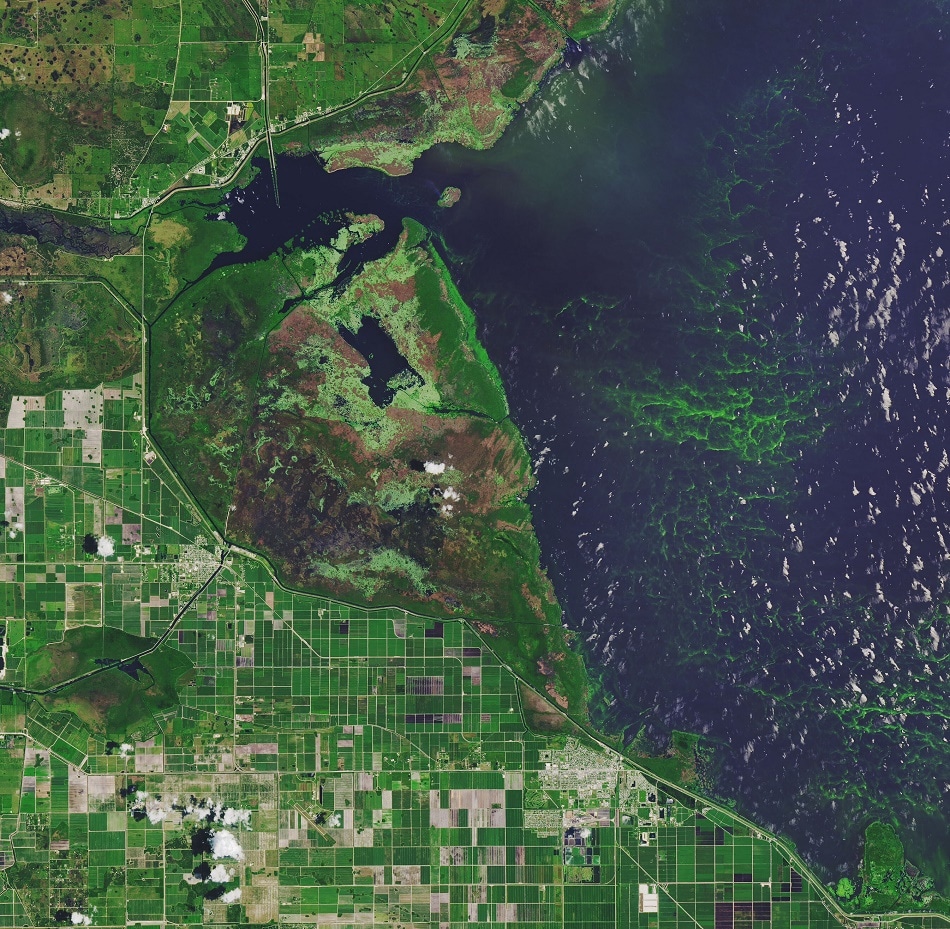 Image credit: NASA Earth Observatory image made by Joshua Stevens, using Landsat data from the U.S. Geological Survey.
Image credit: NASA Earth Observatory image made by Joshua Stevens, using Landsat data from the U.S. Geological Survey.
Freshwater lakes around the world are faced with an alarming statistic; the amount of toxic algal blooms that pose a risk to humans and wildlife are on the rise. This is according to the latest study, the world’s first survey of numerous freshwater lakes spanning three decades, carried out by NASA and Stanford University’s Carnegie Institution for Science.
The algal blooms are a fertile breeding ground for the toxin-producing phytoplankton species which can cause liver damage, respiratory problems, and other fatal illnesses in humans. This toxic surge also has ramifications for animals and the aquatic food supply as well as a range of knock-on effects that impact socio-economic factors.
Toxic algal blooms affect drinking water supplies, agriculture, fishing, recreation, and tourism. Studies indicate that just in the United States, freshwater blooms result in the loss of $4 billion each year.
J.C. Ho, PhD candidate, Carnegie Institute for Science and lead author of the study
The research was conducted using 30 years’ worth of data collected by NASA and the US’s Geological Survey’s Landsat 5 near-Earth satellite. Over the course of the study the team analyzed over 70 lakes across 33 countries and 6 continents. They carefully reviewed long-term trends processing in-excess of 72 billion data points in collaboration with Google Earth Engine. Previous to this study, published by Nature, most prior research had been localized, with an emphasis on small regions across shorter periods of time.
While it is believed climate change is a major contributing factor, the swelling numbers of algal blooms in freshwater lakes can also be caused by chemical run off as a consequence of agricultural and industrial practices as well as ongoing urban development projects.
Yet, the impact of the climate crisis should not be underestimated as the study concluded that over the 30-year timeframe algal blooms stabilized and water quality recovered in only the few lakes that the least amount of warming occurred. Dr. Anna Michalak, co-author and faculty member of Carnegie’s Department of Global Ecology, stated, “This finding illustrates how important it is to identify the factors that make some lakes more susceptible to climate change.”
For the algal blooms to thrive, they require nutrients such as nitrogen and phosphorus. These elements enter the water supply either via surrounding industry and agriculture or after extreme weather events such as heavy rains and storms. Over the course of the study these conditions differed from lake-to-lake. Thus, a multitude of factors in different locations makes breaking down the findings of the study complex.
However, the fact that the study discovered a consistency in the lakes experiencing the least amounts of warming were the ones that also regained and sustained healthy water levels suggests the climate crisis has a significant part to play. “Climate change means extreme weather events are increasing which increases runoff of these chemicals,” said Ho.
The pressing importance of this kind of research is made more relevant because of a series of events that have occurred in recent years due to the boom in algal blooms. In 2014 contamination of the water supply in Lake Eerie led to the shut-down of the Toledo’s water supply, leaving more half a million residents without water for two days. This year, a surge in algae killed an estimated 8 million salmon in Norwegian fish farms, wiping out half a year’s sales growth. Michalak says, “Algal blooms really are getting more widespread and more intense, and it’s not just that we are paying more attention to them now than we were decades ago.”
The findings of Carnegie and NASA illustrate the need for global climate solutions regarding the current climate emergency and expose the vital need to identify the circumstances that make some freshwater lakes more vulnerable than others. With this information, solutions can be developed to ensure safer water conditions for wildlife and communities in surrounding areas. “We need to develop water management strategies that better reflect the ways that local hydrological conditions are affected by a changing climate,” said Michalak.
Disclaimer: The views expressed here are those of the author expressed in their private capacity and do not necessarily represent the views of AZoM.com Limited T/A AZoNetwork the owner and operator of this website. This disclaimer forms part of the Terms and conditions of use of this website.